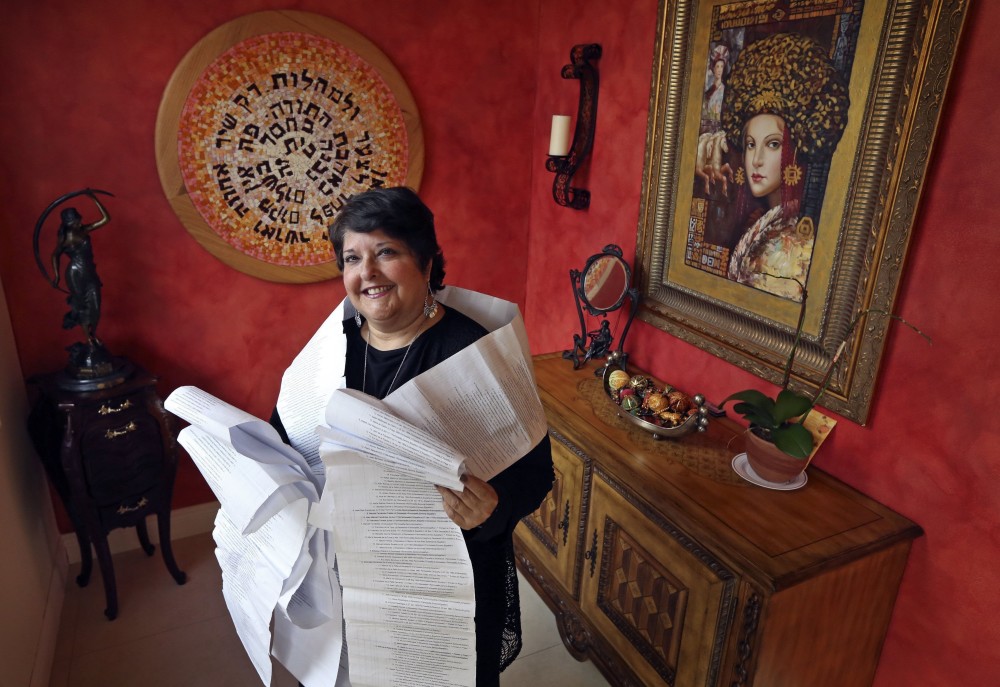By Ana Veciana-Suarez
The Miami Herald
Genie Milgrom’s quest for her religious roots began with a mysterious box her maternal grandmother left her when she died.
It ends, if one can call it an ending, with a book, a website, speaking engagements around the world and a scholar’s depth of knowledge about Jews who were forced to convert, or pretended to convert, by the Spanish Inquisition.
First, the box. Milgrom, who was raised Catholic in a traditional Cuban household, had already converted to Judaism when her maternal abuela left her a well-worn hamsa, or charm-like “hand of God” trinket, and one gold earring with a Star of David in the middle. No note accompanied this strange bequest.
Milgrom was intrigued. What did it mean? This, after all, was the grandmother who, upon Milgrom’s conversion, had whispered a warning about the dangers of being a Jew.
“It was all very mysterious,” said Milgrom, 58, president of her family’s Miami-based pharmaceutical export company. “Then I started remembering all the strange family customs we had, like throwing some of the dough used for baking into the back of the oven and sweeping the floor towards the center of the room and even how we would cracks eggs in a glass to check for blood.”
All Sephardic traditions. All customs practiced by Crypto Jews, those who secretly maintained their Jewish customs while pretending to be Catholic.
Curiosity piqued, Milgrom launched what would become an almost two-decade search for her Jewish roots, a search that took her to her ancestors’ hometown of Fermoselle, a village in the province of Zamora on the Spanish-Portuguese border, as well as to a top Crypto Jewish historian in New Mexico, the head Sephardic rabbi in the U.S. and a rabbinical court in Israel.
The tangible result: “My 15 Grandmothers,” a 158-page self-published book that recounts her odyssey through history. It often reads like a true-life “Da Vinci Code,” complete with underground prayer rooms and enough cinematic twists to give Dan Brown a run for his money.
“It became like a dissertation,” Milgrom said, “but a lot more personal. I was doing this for me, for my children, for my ancestors, for everything they had gone through.”
Milgrom not only traced her genealogy 15 generations through her maternal line, but after writing the book, continued burrowing backward, past the years of the Inquisition and 1492, when the Jews were expelled from Spain. She has now tracked 22 generations of her mother’s maternal line and unearthed centuries-old documents about both her family and Fermoselle as a Jewish settlement.
Abraham Lavender, a Florida International University professor of sociology and Judaic studies, said there has been increased awareness among Hispanic families about possible Jewish ancestry, but few people devote the time and energy to dig for so long and so far.
“She is much more into it than most people,” Lavender said. “Most people go back just a few generations.”
Milgrom, a mosaic artist whose work hangs throughout her spacious Kendall, Fla., home, laughs when asked about her persistence.
“I’m obsessed, 100 percent obsessed. Seriously, though, I wanted to be the voice my grandmothers never had. I wanted to tell people, ‘Here we still are.'”
As a result of her “second career,” as Milgrom calls her genealogical studies, she has become an expert on Crypto Jews and the byzantine process of tracking a family tree through the centuries. She is president of the Jewish Genealogical Society of Greater Miami, the executive vice president of the Society of Crypto Judaic Studies based in Colorado Springs, Colo., and the president of Tarbut Sefarad Fermoselle in Barcelona, an organization that disseminates information on cultural findings of Crypto Jewry. She also has published in scholarly journals.
“Generally we don’t publish personal searches,” said Lavender, who edits the Journal of Spanish, Portuguese, and Italian Crypto Jews.( cryptojewsjournal.org ) “But Genie’s research is so unique and so comprehensive and well documented that it’s certainly at an academic level.”
Milgrom’s experience has morphed into a crusade to help others who are looking for their religious roots. She is now writing a guide book about researching genealogy in Spain. Her own work can serve as a template for others, she believes.
“I don’t proselytize, I don’t go looking for it,” Milgrom said, “but people find me. They hear about my story. I feel I’ve become an advocate for those who want to do what I’m doing.”














































































































































































































































































































































































